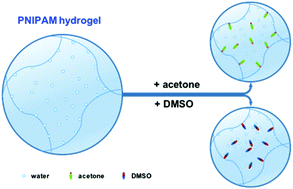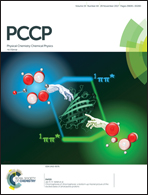Preferential adsorption of the additive is not a prerequisite for cononsolvency in water-rich mixtures†
Abstract
Cononsolvency of poly(N-isopropylacrylamide) (PNIPAM) gels in binary mixed solvents (water–acetone and water–DMSO) has been comparatively investigated by 1H HR-MAS NMR spectroscopy. The results demonstrate that, although the addition of both acetone and DMSO gives rise to cononsolvency behavior, PNIPAM preferentially interacts with acetone rather than DMSO in a water-rich regime, regardless of whether the temperature is above or below the volume phase transition temperature (VPTT). It suggests that the preferential adsorption of the additive cannot be deemed as a prerequisite for the cononsolvency in water-rich mixtures. The underlying molecular mechanism of cononsolvency involves a delicate balance between polymer–solvent and solvent–solvent interactions. Moreover, a new NOE-based NMR approach has been proposed to study the preferential adsorption in this work, which can be extensively adopted to study other relevant processes, including protein hydration, ligand binding, enzyme catalysis, etc.



 Please wait while we load your content...
Please wait while we load your content...